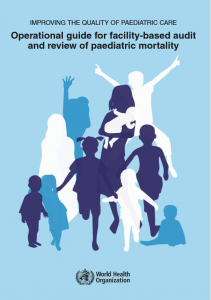
Overview
This operational guide provides guidance for establishing and conducting paediatric death audit and review as part of the overall quality of care improvement at the health facility. Death review or mortality audit is a means of documenting the causes of a death and the factors that contributed to it, identifying factors that could be modified and actions that could prevent future deaths, putting the actions into place and reviewing the outcomes. The objective of audit and review is to determine whether patient care is consistent with evidence based best practices, and to provide feedback to health workers to improve health care practices. It helps in identifying patterns of morbidity, mortality, modifiable factors and interventions to improve the quality of care and outcomes in health care facilities.
This document complements the audit and review of stillbirths and neonatal deaths guide by providing guidance on review and auditing of paediatric deaths; adverse events, near-misses and other paediatric clinical cases of interest.
The aim of paediatric deaths audit and review in hospitals and health facilities is to:
- ensure that all deaths are identified and confidentially discussed;
- assign a cause or causes to each death;
- determine whether the care given was consistent with evidence-based clinical practice, standards of care or the care desired by professionals;
- determine the social, environmental and nutritional risk factors for any death;
- determine possible modifiable factors in the care of each child who dies;
- change modifiable factors to improve the quality of care and avoid similar deaths in the future;
- provide an opportunity for reflection and support to health care workers; and
- ensure that health care workers are committed to learning and improving their practice.
This operational guide describes the key components in establishing a national, subnational and facility mortality and morbidity audit and review systems. It outlines the principles for conducting facility based child death audit and review in hospitals, and the six steps in the audit cycle: (i) identifying cases, (ii) collecting information, (iii) identifying the causes of death and potentially modifiable factors, (iv) recommending solutions or actions, (v) implementing an action plan and making changes and (vi) monitoring and evaluating the process and the outcomes and refining practice as necessary. The annexes provide simplified International Classification Disease (ICD) 11 codes for child death audits and reviews and examples of standard reporting forms, which could be adapted to local and national contexts.
Mortality audit or review system requires leadership and ownership by health workers and national programmes. It is important to understand the structures, systems, regulations and policies in place and what are the scalable best practices.